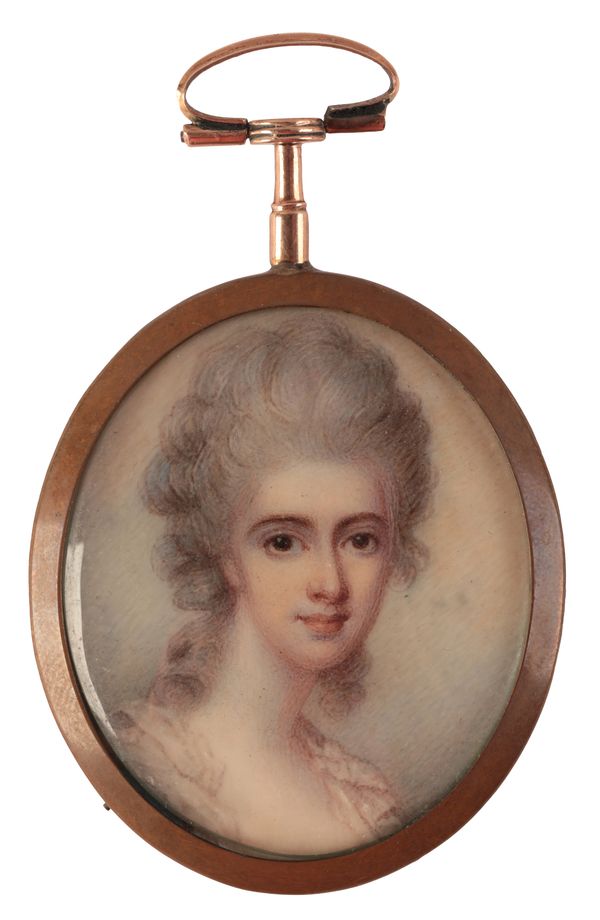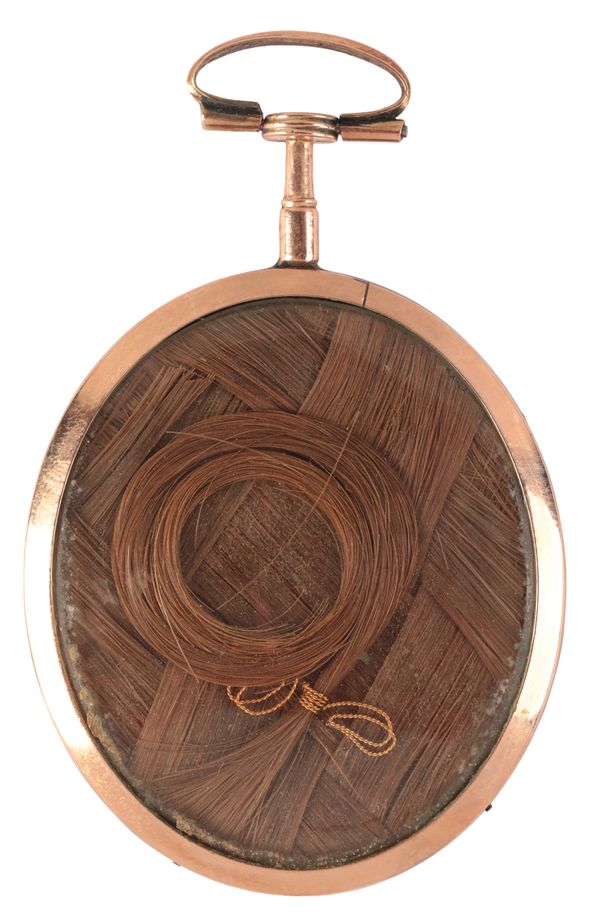A portrait of a lady, traditionally called Georgiana, Duchess of Devonshire watercolour on ivory,
the reverse with tied and plaited hairwork, 4.2cm x 3.6cm
Provenance: Judy & Brian Harden Antiques, Bourton-on-the-Water, Gloucestershire
Private collection, Somerset.
Ivory submission reference: F2GRRYRW
| Condition Report: | click here |
| Estimate: | £4,000 - £8,000 |
Georgiana, Duchess of Devonshire (1757-1806)
Georgiana was the eldest daughter of John Spencer, first Earl Spencer (1734–83). The family travelled widely during Georgiana’s childhood and entertained a variety of celebrated literary and political figures. As a result, Georgiana developed a sophistication and charm which Horace Walpole, art historian and writer, noted, ‘make her a phenomenon’.
In 1774, she married the 5th Duke of Devonshire and soon became a fashion icon. She popularised the three-foot ostrich-feather headdress, extravagant hair towers and the free-flowing muslin dress that was simply tied by a ribbon around the waist. She also, however, became addicted to gambling, a lifestyle she came to regret, she wrote: ‘But my heart now feels an emptiness in the beau monde which cannot be filled … nobody can think how much I am tired sometimes with the dissipation I live in’. Georgiana became enthusiastically involved in politics and, during the French invasion scare of 1778, she formed a female ‘battalion’ of leading Whig women, who dressed in the style of their husbands’ regiments and accompanied the men to the military training camps. Her support for the Whig party in the Westminster election of 1786 brought accusations from the Morning Post that she was exchanging kisses for votes. She did finally stop gambling, but she was never able to pay off her debts. Her domestic arrangements sparked gossip and disapproval as she and the Duke lived with Lady Elizabeth Foster, her best friend, who bore the Duke two illegitimate children and became his second wife in 1809, after Georgiana’s death.
Richard Cosway
Richard Cosway was born in Devon, the son of the headmaster of Blundell's school, Tiverton. The family were prosperous, and owned a woollen business and property. At the age of 12, Richard was sent to London to study drawing under Thomas Hudson at Shipley's drawing school. He entered the Royal Academy Schools in 1769 and exhibited at the Royal Academy between 1770 and 1806. He married Maria Hadfield in 1781, an accomplished artist herself. The couple had one daughter, who died at the age of seven. Richard Cosway's portrait of Maria Fitzherbert attracted the attention of the Prince of Wales who appointed him as his official miniature painter in 1786 and general advisor for the decoration of Carlton House, his residence in London. In 1811, however, Cosway lost the Prince's favour and his eyesight began to fail. He was an eccentric and outlandish in his behaviour and dress, but was an astute collector and acquired a fine collection of old master drawings. His miniatures are painted with a delicacy and fine modelling, and he developed the technique of using transparent pigments which allows the natural luminosity of the ivory to shine through.
Portrait and hair work appear to be in good order with no obvious signs of damage or restoration. The front and rear elements of the frame appear to be two different types of metal, with the front appearing unpolished and the rear and suspension loop are polished.


